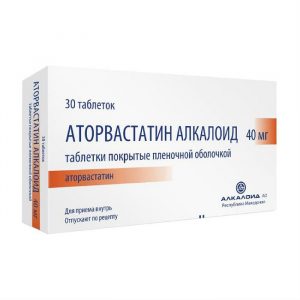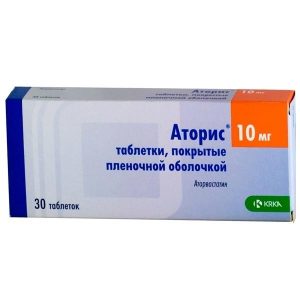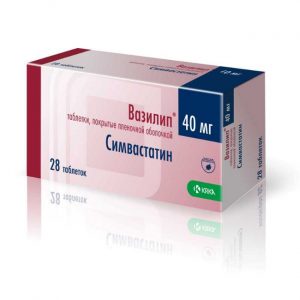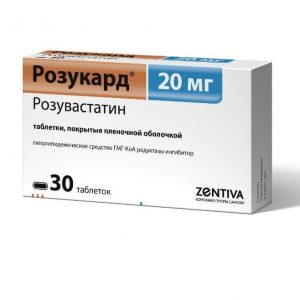Description
Description
Biconvex tablets coated with a white film coating.
Pharmacological action
Hypolipidemic agent from the group of statins. Selective competitive inhibitor of HMG-CoA reductase, an enzyme that converts 3-hydroxy-3-methylglutaryl coenzyme A to mevalonic acid, a precursor of sterols, including cholesterol. Triglycerides (TG) and cholesterol in the liver are included in the composition of very low density lipoproteins (VLDL), enter the blood plasma and are transported to peripheral tissues. Low density lipoproteins (LDL) are formed from VLDL during interaction with LDL receptors. Atorvastatin reduces plasma cholesterol and lipoprotein levels by inhibiting HMG-CoA reductase, the synthesis of cholesterol in the liver and an increase in the number of hepatic LDL receptors on the cell surface, which leads to increased uptake and catabolism of LDL. Reduces the formation of LDL, causes a pronounced and persistent increase in the activity of LDL receptors. Decreases LDL in patients with homozygous familial hypercholesterolemia, which usually does not respond to therapy with lipid-lowering drugs. Lowers total cholesterol by 30-46%, LDL – by 41-61%, apolipoprotein B – by 34-50% and TG – by 14-33% causes an increase in the level of HDL cholesterol (high density lipoproteins) and apolipoprotein A. Dose-dependently reduces the level of LDL in patients with homozygous hereditary hypercholesterolemia resistant to therapy with other lipid-lowering drugs.
Indications
Atorvastatin is used:
in combination with a diet to reduce elevated levels of total cholesterol, cholesterol / LDL, apolipoprotein B and triglycerides and increasing HDL cholesterol in patients with primary hypercholesterolemia, heterozygous familial and non-familial hypercholesterolemia and combined (mixed) hyperlipidemia (types IIa and IIb according to Fredrickson)
in combination with type II triglycerides according to Fredrickson) and patients with dysbetalipoproteinemia (type III according to Fredrickson) in whom diet therapy does not give an adequate
effect to lower total cholesterol and cholesterol / LDL in patients with homozygous familial hypercholesterolemia, when diet therapy and other nonpharmacological treatments are not effective enough.
Recommendations for the use of
Before prescribing atorvastatin, the patient should be advised of a standard lipid-lowering diet, which he must continue to follow throughout the duration of therapy.
The initial dose is an average of 10 mg 1 time / day. The dose varies from 10 to 80 mg 1 time / day.
The drug can be taken at any time of the day with food or regardless of the meal time. The dose is selected taking into account the initial levels of cholesterol / LDL, the purpose of therapy and individual effect. At the beginning of treatment and / or during an increase in the dose of Atorvastatin, it is necessary to monitor plasma lipid levels every 2-4 weeks and adjust the dose accordingly.
Primary hypercholesterolemia and mixed hyperlipidemia, as well as type III and IV according to Fredrickson.
In most cases, a dose of 10 mg of Atorvastatin once daily is sufficient. A significant therapeutic effect is observed after 2 weeks, as a rule, and the maximum therapeutic effect is usually observed after 4 weeks. With prolonged treatment, this effect persists.
Homozygous familial hypercholesterolemia.
Assign a dose of 80 mg (4 tablets of 20 mg) 1 time per day.
The use of the drug in patients with renal failure and kidney disease does not affect the level of atorvastatin in the blood plasma or the degree of decrease in cholesterol / LDL when it is used, therefore, changing the dose of the drug is not required.
In case of hepatic insufficiency, the dose should be reduced (see section “With caution” and “Special instructions”).
When using the drug in elderly patients, there were no differences in safety, effectiveness or achievement of the goals of lipid-lowering therapy in comparison with the general population.
Special instructions
Before starting therapy with atorvastatin, the patient must be prescribed a standard hypocholesterol diet, which he must observe during the entire period of treatment.
The use of HMG-CoA reductase inhibitors to lower blood lipids can lead to a change in biochemical parameters that reflect liver function. Liver function should be monitored before starting therapy, 6 weeks, 12 weeks after starting atorvastatin and after each dose increase, and periodically, for example, every 6 months. An increase in the activity of liver enzymes in the blood serum can be observed during therapy with Atorvastatin. Patients with an increase in enzyme levels should be monitored until the enzyme levels return to normal. In the event that the values of alanine aminotransferase (ALT) or aspartic aminotransferase (AST) are more than 3 times higher than the upper acceptable limit, it is recommended to reduce the dose of atorvastatin or discontinue treatment.
Atorvastatin should be used with caution in patients who abuse alcohol and / or have liver disease. Active liver disease or a persistent increase in the activity of aminotransferases of unknown origin serve as contraindications to the appointment of Atorvastatin.
Treatment with atorvastatin may cause myopathy. The diagnosis of myopathy (muscle pain and weakness in combination with an increase in the activity of creatine phosphokinase (CPK) by more than 10 times compared with the upper limit of the norm) should be discussed in patients with common myalgia, pain or muscle weakness and / or a marked increase in CPK activity. Patients should be warned that they should immediately inform the doctor about the appearance of unexplained pain or weakness in the muscles, if they are accompanied by malaise or fever. Atorvastatin therapy should be discontinued if there is a marked increase in CPK activity or in the presence of confirmed or suspected myopathy. The risk of myopathy in the treatment of other drugs of this class increased with the simultaneous use of cyclosporine, fibrates, erythromycin, nicotinic acid or azole antifungal agents. Many of these drugs inhibit the metabolism mediated by cytochrome P450 3A4 and / or drug transport. Atorvastatin is biotransformed under the influence of CYP 3A4. Prescribing atorvastatin in combination with fibrates, erythromycin, immunosuppressive agents, azole antifungal agents or nicotinic acid in hypolipidemic doses, the expected benefit and risk of treatment should be carefully weighed and patients should be regularly observed to detect muscle pain or weakness, especially during the first months of treatment and during periods of increasing doses of any drug. In such situations, periodic determination of CPK activity can be recommended, although such control does not prevent the development of severe myopathy.
When using Atorvastatin, as well as other drugs of this class, cases of rhabdomyolysis with acute renal failure due to myoglobinuria are described. Atorvastatin therapy should be temporarily discontinued or completely discontinued if there are signs of a possible myopathy or a risk factor for the development of renal failure due to rhabdomyolysis (e.g., severe acute infection, arterial hypotension, serious surgery, trauma, severe metabolism, endocrine and electrolyte disturbances and uncontrolled convulsions).
Before starting Atorvastatin therapy, it is necessary to try to achieve control of hypercholesterolemia by adequate diet therapy, increased physical activity, weight loss in patients with obesity and treatment of other conditions.
Patients should be warned that they should immediately consult a doctor if unexplained muscle pain or weakness occurs, especially if they are accompanied by malaise or fever.
Influence on ability to drive a car and work with mechanisms
No adverse effects of Atorvastatin on ability to drive a car and work with mechanisms were reported.
Composition of
One film-coated tablet contains:
active substance: atorvastatin calcium trihydrate – 10.85 mg, which corresponds to 10 mg of atorvastatin
excipients: calcium carbonate – 33.00 mg, microcrystalline cellulose – 48.00 mg, lactose monohydrate (milk sugar) – 23.85 mg, pregelatinized starch (starch 1500) – 32.80 mg, colloidal silicon dioxide (Aerosil) – 0.75 mg, magnesium stearate – 0.75 mg, polyvinyl alcohol – 2.50 mg, macrogol (polyethylene glycol) – 1.26 mg, talc – 0.93 mg, titanium dioxide – 1.56 mg.
Overdose
Treatment: there is no specific antidote, symptomatic therapy is carried out.
Hemodialysis is ineffective.
Storage conditions
In a dry, dark place at a temperature of no higher than 25 ° C.
Keep out of the reach of children.
Expiration
3 years. Do not use after the expiration date indicated on the package.
Active ingredient
Atorvastatin
dosage form
tablets




